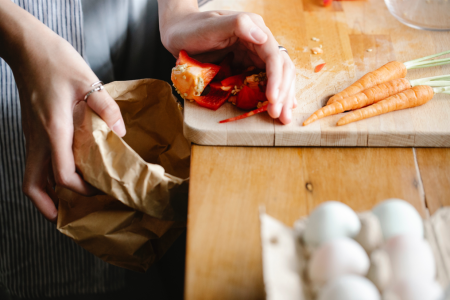Australian supermarkets making $1.2 billion yearly from wasted food, report reveals
Supermarket giants have recently announced record profits, and it appears that a significant part of their success is fuelled by Australian households carelessly throwing out food.
According to the progressive think tank The Australia Institute, Aussie households waste $19.3 billion of food annually—the equivalent of 152 Sydney Harbour Bridges.
That’s 7.6 million tonnes of food Aussies have thrown out, equivalent to $2,000 or $25,000 per household.
'Ironically, the wasting and repurchasing of food contributes to the rising cost of living, further exacerbating these financial pressures,' the report claimed.
The study examined food waste data from 2018-2019 and the National Food Waste Strategy Feasibility Study commissioned by the government two years ago.
Shockingly, for households struggling to keep up with their weekly grocery bills, the report also mentioned that food retailers profited up to $1.2 billion annually from the products being thrown away.
'If the average rate of profit across the industry is 6.1 per cent, and we assume that the $19.3 billion worth of food wasted by households returned this average profit, then the profit earned on the wasted food was $1.2 billion,' the report explained.
The researchers clarified: ‘It is important to note that this $1.2 billion represents the profit earned by food retailers alone from food waste. It does not include income and expenses by other upstream industries such as growers and food processors when they produce food that is never eaten.'
The report, titled ‘Food Waste in Australia and How Supermarkets Profit from It’, cited strict cosmetic standards on the appearance of produce as a factor for them being wasted.
Food Innovation Australia Limited (FIAL) created a roadmap last 2021, highlighting possible campaign and policy changes to help reduce the country’s food waste.
The report's authors claimed the possibility of halving the country’s food waste within the next decade, but federal and state governments need $7-7.5 billion to make it a reality.
'For every $1 spent on food waste interventions, this scenario delivers a minimum of $7 benefit back to the economy,' FIAL's report said.
'This return on investment will only increase as the social cost of carbon and landfill costs increase over time,’ it added.
The Australian Institute’s Senior Economist Matt Grudnoff said if the government introduced reforms, Australians could halve their food waste within the next decade and save billions of dollars.
'It proposed removing best-before dates from products that do not need them, scrapping sell-by or display-until dates and extending allowable use-by dates for long-life products,' he said.
'If that means trimming the profits that Coles and Woolies make from food waste, well, that's a price I think most Australians would be happy to pay,' he continued.
You can read more about their report here.
In August, Woolworths posted a $1.62 billion after-tax profit—a 4.6 per cent increase from last year.
On the other hand, Coles recorded a 4.8 per cent rise on their 2021-2022 profits, with $1.1 billion net profit.
Both retailers have existing food waste policies, including donations to hunger relief programs like Foodbank and OzHarvest.
Coles has a sustainability policy also that redirects fruits and vegetables not sold into products, like using bananas for banana bread or muffins.
A Coles spokeswoman said, 'We recognise that food waste is a significant issue in Australia and are supportive of considered industry reform that seeks to address the problem.’
‘We are committed to working collaboratively with government and industry to progress discussions around use-by labelling practices,’ she added.
In the last financial year, 84 per cent of the company’s landfill was diverted, and unsold and edible food valued at $133 million was given to its food support programs.
Meanwhile, Woolworths has The Odd Bunch range, which sells food and vegetables not up to their display standards.
They also shared that they’re investing $123 million over the next decade to help address food waste.
'We work hard to reduce food waste, with our supermarket teams saving more than 80 per cent of food waste from landfill. Not only is it the right thing for our customers and the environment, but it is also good business,' a Woolworths spokesman stated.
'Every year, Use By and Best Before dates alone cost our business tens of millions of dollars in food that can't be sold—so we have every incentive to increase the shelf life of products in our supply chain where possible,’ he continued.
'Use By dates play an important role in food safety and can reduce food waste by helping customers use up food before it becomes inedible, so it's important that food manufacturers get these things right,' the spokesman advised.
Woolies donated 28 million meals worth of extra food to hunger charities last financial year. We also published an article earlier about the company’s donation to a community pantry in Lomandra. You can read more about that here.

Members, this report is a timely reminder for us all to be conscious of the food we’re buying and ensure we’re using it.
Store up leftovers in the fridge and remember to use them up. Give your fruit bowl a quick check before you head to the shops, and strive to buy less on each shopping trip.
What do you think of this story, members? Do you have tips on how to avoid food waste? Let us know in the comments below!
According to the progressive think tank The Australia Institute, Aussie households waste $19.3 billion of food annually—the equivalent of 152 Sydney Harbour Bridges.
That’s 7.6 million tonnes of food Aussies have thrown out, equivalent to $2,000 or $25,000 per household.
'Ironically, the wasting and repurchasing of food contributes to the rising cost of living, further exacerbating these financial pressures,' the report claimed.
The study examined food waste data from 2018-2019 and the National Food Waste Strategy Feasibility Study commissioned by the government two years ago.
Shockingly, for households struggling to keep up with their weekly grocery bills, the report also mentioned that food retailers profited up to $1.2 billion annually from the products being thrown away.
'If the average rate of profit across the industry is 6.1 per cent, and we assume that the $19.3 billion worth of food wasted by households returned this average profit, then the profit earned on the wasted food was $1.2 billion,' the report explained.
The researchers clarified: ‘It is important to note that this $1.2 billion represents the profit earned by food retailers alone from food waste. It does not include income and expenses by other upstream industries such as growers and food processors when they produce food that is never eaten.'
The report, titled ‘Food Waste in Australia and How Supermarkets Profit from It’, cited strict cosmetic standards on the appearance of produce as a factor for them being wasted.
Food Innovation Australia Limited (FIAL) created a roadmap last 2021, highlighting possible campaign and policy changes to help reduce the country’s food waste.
The report's authors claimed the possibility of halving the country’s food waste within the next decade, but federal and state governments need $7-7.5 billion to make it a reality.
'For every $1 spent on food waste interventions, this scenario delivers a minimum of $7 benefit back to the economy,' FIAL's report said.
'This return on investment will only increase as the social cost of carbon and landfill costs increase over time,’ it added.
The Australian Institute’s Senior Economist Matt Grudnoff said if the government introduced reforms, Australians could halve their food waste within the next decade and save billions of dollars.
'It proposed removing best-before dates from products that do not need them, scrapping sell-by or display-until dates and extending allowable use-by dates for long-life products,' he said.
'If that means trimming the profits that Coles and Woolies make from food waste, well, that's a price I think most Australians would be happy to pay,' he continued.
You can read more about their report here.
In August, Woolworths posted a $1.62 billion after-tax profit—a 4.6 per cent increase from last year.
On the other hand, Coles recorded a 4.8 per cent rise on their 2021-2022 profits, with $1.1 billion net profit.
Both retailers have existing food waste policies, including donations to hunger relief programs like Foodbank and OzHarvest.
Coles has a sustainability policy also that redirects fruits and vegetables not sold into products, like using bananas for banana bread or muffins.
A Coles spokeswoman said, 'We recognise that food waste is a significant issue in Australia and are supportive of considered industry reform that seeks to address the problem.’
‘We are committed to working collaboratively with government and industry to progress discussions around use-by labelling practices,’ she added.
In the last financial year, 84 per cent of the company’s landfill was diverted, and unsold and edible food valued at $133 million was given to its food support programs.
Meanwhile, Woolworths has The Odd Bunch range, which sells food and vegetables not up to their display standards.
They also shared that they’re investing $123 million over the next decade to help address food waste.
'We work hard to reduce food waste, with our supermarket teams saving more than 80 per cent of food waste from landfill. Not only is it the right thing for our customers and the environment, but it is also good business,' a Woolworths spokesman stated.
'Every year, Use By and Best Before dates alone cost our business tens of millions of dollars in food that can't be sold—so we have every incentive to increase the shelf life of products in our supply chain where possible,’ he continued.
'Use By dates play an important role in food safety and can reduce food waste by helping customers use up food before it becomes inedible, so it's important that food manufacturers get these things right,' the spokesman advised.
Woolies donated 28 million meals worth of extra food to hunger charities last financial year. We also published an article earlier about the company’s donation to a community pantry in Lomandra. You can read more about that here.
Key Takeaways
- Australian households are wasting nearly $20 billion annually by discarding food, equating to the weight of 152 Sydney Harbour Bridges.
- This wasted food allows retailers to profit approximately $1.2 billion annually.
- A report from The Australia Institute suggests reforms are needed to reduce food waste if Australia aims to halve food waste in the next decade.
- Both Coles and Woolworths have policies to combat food waste and contribute to hunger relief programs.
Members, this report is a timely reminder for us all to be conscious of the food we’re buying and ensure we’re using it.
Store up leftovers in the fridge and remember to use them up. Give your fruit bowl a quick check before you head to the shops, and strive to buy less on each shopping trip.
What do you think of this story, members? Do you have tips on how to avoid food waste? Let us know in the comments below!








